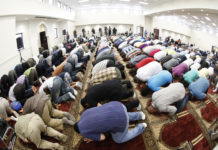ERBIL, Kurdistan Region – A farmer from Erbil has discovered a new, hardier breed of goat, mating a male wild goat with a female local goat known as Maraz. The resulting offspring has distinctive looks and commands five times the price as Maraz goats.
Just like wild goats, the new goat is agile and appealing to look at. It eats less, can withstand extreme cold, and reproduces better than local goats. One of the striking attributes of this hybrid goat is that 70 percent of its offspring are twins.
Salman Berokaye is a local farmer from the city of Erbil. He has been combining these two different goats to produce distinctive hybrid goats for the past 15 years. He currently owns 360 hybrid goats. “I got two male wild goats. One of them was from Barzan and the other one was a European goat. I combined them with the Maraz goats.”
“As a result of these combinations, I have now gotten goats which are even more beautiful than wild goats,” he said.
These hybrid mechanisms of reproducing animals are intended to produce newborns with new and distinctive characteristics.
If the hybrid, inheriting 50% of the attributes of the male animal, is combined again with the wild male, the next generation produced consequently will inherit 75% of the attributes of the reproducing male animal. The more you combine them this way, the more dominant the features of the reproducing male animal will be on the newborn.
“The third hybrid reproduction between a male wild goat and a female Maraz goat produces a very beautiful newborn which is very similar to the wild goat. One can hardly distinguish them,” Berokaye explained, adding, “90% of the newborns from these hybrid reproductions turn out to look like wild goats.”
Kurdish goats known as Maraz are mostly kept in mountainous regions like Hawraman, Rania, Qaladze, Khoshnawati, Mergasor, Zakho and Akre. Maraz goats are smaller in size than other goats and weigh between 30 to 35 kilograms. They, however, have good fur.
“Goats produced from hybrid reproductions make more money. Two Maraz goats make nearly 350,000 Iraqi Dinars (IQD, about $300), whereas a hybrid goat makes nearly 1 million IQD or more than 2.5 million IQD if the goat is beautiful,” Berokaye detailed.
Some local farmers have been raising hybrid goats on their farms for a few years as there is high demand for them in the Kurdistan Region.
Masoud Mohammed owns a farm where he raises animals, including poultry and goats. He has been producing hybrid goats for four years now, but has problems with male wild goats.
“Male wild goats cannot withstand the heat wave of Erbil. They will die if you don’t keep them in appropriate weather conditions. In addition, they can only mate from mid-January to the beginning of February, while the local female goats are normally ready to mate in July and August. She should therefore be kept away from other male goats until the male wild goats are ready to copulate. Furthermore, the female newborns produced from these hybrid reproductions have, after they themselves reproduce, little milk which is only enough for their baby goats,” Mohammed said.
The hybrid goats have many good qualities too, Mohammed detailed. “The weight of the next generation of goats produced through these hybrid reproductions increases by 30 percent. Their meat is also more delicious. They withstand the cold and the heat and do not eat much, too.”
“These hybrid reproductions are also good for the environment, making people no longer hunt wild goats as they can easily buy them in the market for a reasonable price whether they will then use them for their meat or raise them,” he added.
“In order for these hybrid reproductions to lead to good results, research should be conducted on them and a solution should be found for the high mortality rate among the reproduced goats,” Dr. Yousif Barzinji, a lecturer at the Faculty of Agriculture in Salahaddin University, said.
“Although these hybrid reproductions are in demand and have economic benefits to farmers, Maraz goats should not be ignored as it is economically more advantageous to raise them due to their fur, which could be used as raw material in factories.”
[This post was originally published by Rudaw, a Kurdish News portal and republished here with permission.]







![283274Image1[1]](http://meccapost.com/wp-content/uploads/2017/02/283274Image11-300x187.jpg)

